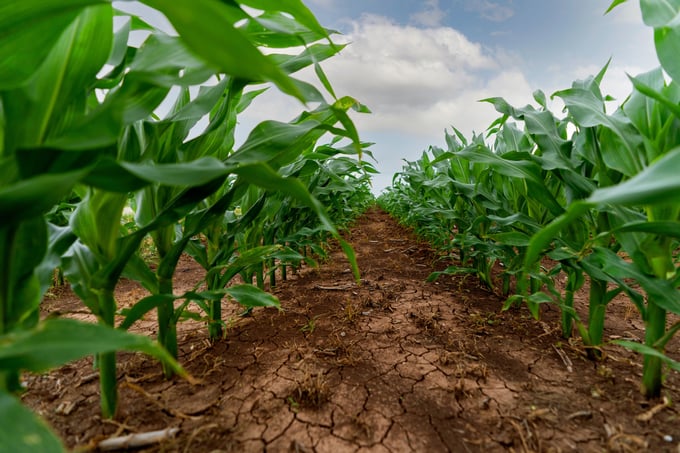November 27, 2025 | 19:31 GMT +7
November 27, 2025 | 19:31 GMT +7
Hotline: 0913.378.918
November 27, 2025 | 19:31 GMT +7
Hotline: 0913.378.918

Corn plantings continue around the state and many fields are emerged and progressing, but many producers are switching from corn due to drought conditions. Texas A&M AgriLife photo by Laura McKenzie.
Phosphorus, potassium, sulfur and nitrogen. All are traditional nutrients growers plan to put into soil each year to help maximize their yield potential. But did you know there are three other major components that are often overlooked?
Carbon, oxygen and hydrogen make up nearly 94% of the dry weight of the corn plant and play a pivotal role in grain yield. But they are rarely, if ever, part of a fertility plan. Instead, these nutrients are considered “freebies” because they do not need to be applied as fertilizer in crop production.
Carbon, oxygen and hydrogen are principal components of starch, protein, oil and fiber, which comprise about 85% of the final grain yield. The remaining 15% is water. They are important nutrients, but what can corn producers do to increase carbon, oxygen and hydrogen uptake?
The key to managing these essential nutrients is to manage soil water. If the soil contains too much water, mitochondria in the corn root cells suffocate from lack of oxygen and die, leading to overall root death.
If the soil contains too little water, evapotranspiration is limited, plant stomates close, and very little carbon dioxide and oxygen are captured in stomatal chambers. Reduced carbon dioxide levels limit the amount of carbon that is converted into sugar. Reduced oxygen levels inhibit mitochondrial respiration for energy production. Limitations of both functions reduce grain yield.
As long as soil water content is greater than the wilting point and not over field capacity, corn grows properly. Management practices to better ensure maximum corn growth and yield include:
Install tile drainage to more rapidly remove excess water during rainy periods.
Manage soil tillage to create a soil structure that allows maximum water percolation and capture from rain or irrigation.
Improve the soil structure to allow better water retention.
Conserve soil moisture by maintaining surface residue to reduce evaporation.
Fertilize properly to allow the corn plant to efficiently capture carbon.
Select hybrids that perform well in drier environments.
(farmprogress)

(VAN) A new study reveals how the simultaneous effects of ocean acidification, salinity and loss of oxygen are making the world more fragile.

(VAN) Hopes are growing that the creation of the first 3D turkey gut model could be a turning point in the battle against the virulent blackhead disease.

(VAN) Tyson, America’s biggest meat supplier, plans to shutter one of its largest beef processing plants as the industry continues to struggle with low cattle supplies and political pressure from Washington.

(VAN) New FAO study shows how digital solutions are empowering farmers and fishers to prevent losses and build resilient agrifood systems.

(VAN) Brazil's COP30 presidency pushed through a compromise climate deal on Saturday that would boost finance for poor nations coping with global warming but that omitted any mention of the fossil fuels driving it.

(VAN) Poultry farmers in the UK have been warned that they could face one of the worst winters yet for bird flu.

(VAN) Prices of main-crop paddy have risen sharply, with jasmine rice hitting 16,100 baht per tonne — the highest level in years.